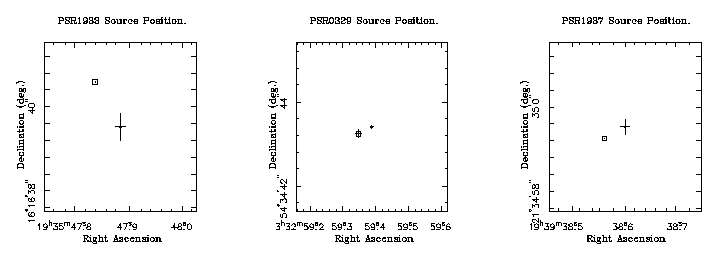Pulsar VLBI
Kashima(Japan)-Kalyazin(Russia) Pulsar VLBI Experiment in 1995
M. Sekido, Y.Takahashi, Y.Koyama
Kashima Space Research Center
Communications Research Laboratory
893-1 Hirai, Kashima, Ibaraki 314, Japan
Y. Hanado, M.Imae
Communications Research Laboratory
4-2-1 Nukui-kita, Koganei, Tokyo 184, Japan
Yu. P. Ilyasov, A. E. Rodin,
A. E. Avramenko, V. V. Oreshiko
Astro Space Center P.N. Lebedev Physical
Institute, Russia
B. A. Poperchenko
Special Research Bureau of the Moscow Power
Engineering Institute, Russia
1. Introduction
Pulsars are high-velocity objects (Lyne 1994) and their positions and
proper motions are important for our understanding of the formation and
evolution of pulsars. Accurate astrometric measurements by
inter-continental VLBI observation will determine the positions and
proper motions of pulsars in several years interval observations.
2. Observation and data acquisition
A VLBI experiment observing pulsars and reference sources was carried out
by Kashima(Japan)-Kalyazin(Russia) baseline in March of 1995. This
experiment was organized by collaboration between Communications
Research Laboratory (CRL) and Lebedev Physical Institute of Russian
Academy of Science (LPI). The antenna diameter and efficiency of
Kashima and Kalyazin are 34m, 60%, and 64m, 60% respectively.
Observation frequency band 1.4GHz was down converted to video band and
divided into 16 channels with each 2MHz width. Data of each channel
are sampled with 4Mbps sampling rate and recorded by K-4 VLBI recorder.
This was the first VLBI experiment between Kashima and Kalyazin,
therefore making sure of the direction of circular polarization, as
well as of the coordinates of Kalyazin station was main purpose of
this experiment.
3. Data processing
The K3 correlator, developed by CRL, was used for cross correlation
processing. First fringes were successfully detected. K3 correlator
has a gating function, which enhance the Signal to Noise Ratio (SNR) of
pulsar data by accumulating only a part of the pulsar's signal.
Initially we processed the pulsar data without the gating function.
Correlation processing with gating function will be done soon. By using
the gating function, weak pulsars, which have not yet been observed with
interferometric methods, will become observable.
4. Preliminary result
A MkIII database, which is used for ordinary geodetic analysis data
storage, was made for pulsar VLBI data. The analysis software Solve, which
is widely used for geodetic analysis, was used to analyze the position
of pulsars. In Fig.1, mark $\bullet$ shows the result of
this experiment and open suare symbols
shows the position from Taylor's catalog
(J.H.Taylor 1993). The discrepancies between the results and catalog
position may be due to several reasons. The main reason is
ionospheric delay: ionospheric delay compensation cannot be
done with single band (1.4GHz) data. Another reason may be the difference
of coordinate systems. Timing positions are relative to a reference frame
defined by an ephemeris of Solar system motions, whereas interferometric
positions are relative to equatorial frame defined by the rotation of
the Earth to background extragalactic sources.
5. Future
By applying the pulsar gating function of K3 correlator, SNR will be
enhanced and accuracy of the position will be improved.
This experiment had been organized to analyze the difference of delay
between pulsars and closest reference sources (Differential VLBI). By
applying this method, calibration of ionospheric delay will be improved.
We are planning to equip K4 backend system at Kalyazin station for
a few years. Then we will be able to organize pulsar
VLBI experiments frequently.
Investigation for how we should compensate the ionospheric delay will be
necessary. We are considering of using GPS observation for this purpose.
References
Taylor,J.H., Manchester,R.N., and Lyne,A.G., (1993) Astrophys.J
.Suppl., 88, 529-568. "Catalog of 558 Pulsars"
Lyne,A.G., and Lorimer,D.R. (1994). Nature 369, pp.127-129.,
"High birth velocities of radio pulsars"

Figure 1. Open circles show the result of this
experiment and open squares
show the position from Taylor's catalog (J.H.Taylor
1993). The discrepancies between the results and catalog position may be
caused
from some reasons. Main reason may be caused from ionospheric delay because
ionospheric delay compensation cannot be done with single band (1.4GHz) data.
Other reason may be the difference of coordinate .
Timing positions are relative to a reference frame defined by an
ephemeris of Solar system motions, whereas interferometric positions are
relative to equatorial frame defined by the rotation of the Earth to
background extragaractic sources.
Updated on November 2, 1995.
Return to CONTENTS
